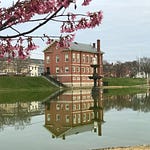Listen to The Saturday Stoke
Subscribe to The Saturday stoke Podcast
What is silence?
How does one remember a time of hush? It’s a sound, but not really. More like what a sound feels like when you live it. More like what a sound looks like when you remember it. That’s what I remember.
That’s what I remember from the morning when Jessie, Sammy, my brother Jon, and I camped in the pine grove off of old Seglock Road. Eight inches of snow on the ground, six more on the way. We hiked back in after dark because you’re not supposed to camp in the Pennsylvania Game Lands. We reached the pine grove Jon and I found the day before. We dug out the snow and collected wood, built a fire, and ate Chunky Soup.
I woke early, just before dawn. The night’s raging fire still smoked. We’d all slid into a bunch; crammed together—asleep and warm.
I poked the fire and got it going. Each sound, something you could feel. The sun rose, but I couldn’t see it. It just lit up the low hanging clouds with a soft glow. The guys didn’t move. I sat in the silence, watching the coals kindle and grow into flame.
Then, a flake.
And another.
More.
Then, an even fall tumbled through the pines. The smoke rose, the snow fell, and my breathing slowed as the woods turned into an anechoic chamber of timber and white.
Then, quiet footsteps? Hoof steps? What was coming?
Through the pines a lone deer walked towards the campsite. It stopped and looked at me. Was it inspecting the fire? Me? Then, it continued on and out of sight. The careful crunch of the deer’s gate, the nothing sound of falling snow, the inaudible dance of the morning fire, and my own breathing.
A hush.
That’s what I remember. A moment bottled up in my memory; silent, wonderful, beautiful.
There is a fullness to silence that’s hard to explain.
That moment in the snow, with the deer, still stirs emotions within me. But when I reflect on that snapshot of beauty, I am struck by the audible silence of the experience.
We tend to think of silence as the absence of sound, a kind of vacuity, and that is certainly an angle to consider. But this moment of beauty resounded with the hush of silence. Instead of thinking of silence as the absence of something, what if we thought of it differently?
Have you ever thought about silence as something more than absence?
Silence cripples us.
In South Minneapolis, Orfield Laboratories built the quietest room on the planet, an anechoic chamber capable of absorbing 99.99% of sound. It is said a human being can last only forty-five minutes in the room before hallucinating or breaking down.
Founder Steven Orfield says in a room such as the anechoic chamber, a person’s ears will adapt to the silence and pick up sounds within the body, like a heartbeat or stomach churn. In a room of utter quiet, the human becomes the sound, and this reality can disorient a person, making it nearly impossible to even stand.
Silence also lures and woos us.
On August 29, 1952 pianist David Tudor took the stage at the famous Maverick concert hall, which is located just south of Woodstock, New York. Over the next four minutes the musician made no audible sounds, played no notes on the piano, but simply turned the pages of the piece he was performing. The pages contained no notes.
When four minutes and thirty three seconds passed, Tudor stood to a resounding ovation. The performance marked the debut of what would become John Cage’s most influential and controversial work: 4’33” or “four thirty three”.
Cage described the sounds he heard during the three movements of four thirty three on that summer day at the Maverick: “What they thought was silence, because they didn’t know how to listen, was full of accidental sounds. You could hear the wind stirring outside during the first movement. During the second, raindrops began pattering on the roof, and during the third the people themselves made all kinds of interesting sounds as they talked or walked out.”
Composer and scholar Kyle Gann says that Cage himself considered four thirty three not a piece of provocation, but “an act of framing.” The piece gathered the sounds from the immediate environment in a moment of attention. That moment of attention worked as a way to open the mind to new possibilities in music, “it begged for a new approach to listening.”
So, seen in this light, silence is more about restraint. Not speaking when given the chance. Not sounding your gong just because. It’s the beautiful action of withholding for the sake of others.
Silences beg us to listen.
The iconic Henry David Thoreau said of the Orator, that she is most eloquent when she is most silent, when she becomes part of the audience and listens while she speaks. I wonder how many of us know what it is to listen more than we speak, listen when we speak, and listen in order to speak?
Silence, then, is more than absence. It possesses power, acts as a device for framing life, and instructs us on how to be attentive to others.
Perhaps silence unnerves us so much because it leads to something. A gateway to another place perhaps.
The poet E.E. Cummings describes silence like this: “(now the ears of my ears awake and now the eyes of my eyes are opened).”
Maybe silence is more than absence and is more powerful than any kind of framing device. Maybe silence draws us to something that is beyond sound or its absence.
Philosopher Charles Taylor describes our lives and the places we live as consisting of a spiritual shape. He uses the term “fullness” to describe what it feels like when this shape tops off. We sense this fullness in goosebump moments throughout our lives; times of indelible delight and pure wonderment.
You and I grope for this feeling of fullness in our lives, don’t we? That is what I’m describing to you now as I’ve felt it in my own life; from boyhood to manhood, I remember that feeling of fullness. I can feel that spiritual quality I then might have labeled as wonder or beauty, the time in life when my senses became fully alive—that moment of deep silence and wakefulness. The moment I wanted to scream for joy, and yet held in the gasp and retained the joy for another day, a memory day, a day to break the silence with the reverberations of love.
“But Tim,” you say, “we all know that silence is really about there not being any sound—you know, no noise or distraction and all of that. Aren’t you the preacher of these kinds of, oh what do they call them, oh yes, spiritual disciplines?”
“Ah yes, some say that, no doubt about it. And yes, ole friend, I do agree that silence is about no noise and no distraction. All I’m saying, is that perhaps that’s not all it is. Do you catch my meaning?”
I certainly hope so.
Here’s a quick hack for cultivating more of this life-giving silence in your life.
And friends, the hack today is not some long and drawn out thought. It is simply to find a place away: away from the noise, the clatter, the pressure. And in that place drink in your own four thirty three. Step into your own anechoic chamber and let the fullness of silence, the crippling power of silence dig into you.
And there, in your most vulnerable and exposed moments, whisper to God: “I need you.” And feel the weight of everlasting silence upon your soul.
But we can’t pursue silence when it’s most convenient for us. Any discipline, physical or spiritual, requires consistency and commitment. Instead of sprinting to the your quiet place every few months or maybe even a couple times a year, why not make it a weekly habit? The more familiar you become with silence, with restraint, with listening, the more familiar you will become with the voice of God within you.
I’m listening in the quiet with you.
Stay stoked my friends.













Share this post